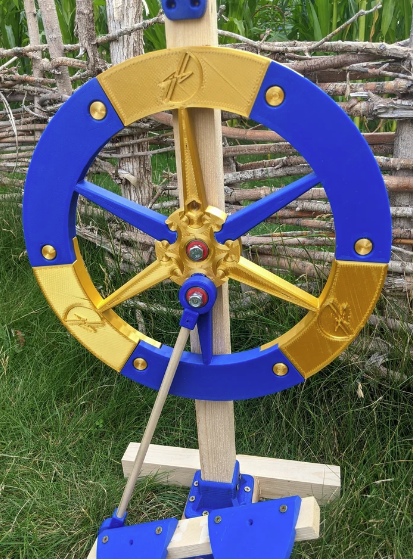|
Guys. It's finally here. The full-sized spinning wheel is live in our Etsy shop. Let me tell you: it was a brutally fulfilling prototyping process. Skeeter, D'artagnan, and Ivan (our 3D printers) printed more than 60 hours of spokes, bobbins, and whorls. Some parts were too small. Some suffered bed shift or other g-code deformities. But, in the end, Irish swears and constant code modifications prevailed. In all of its glory, I present the full-sized, 3D-printed, Irish Tension Good and Basic Spinning Wheel. I'm taking a moment to bask. Go ahead and move on. The wood on this prototype is unfinished. Joseph was too excited to get the thing assembled and didn't take time to finish the wood, which I would probably want to do if I planned to make this my permanent wheel. A good stain would do nicely, I think. I favor the Kona stain from Rust-Oleum, which would provide a lovely, dark contrast to the gold filament. (That's the bronze one in the middle with the dark wood.) To match the red filament, I'm imagining something with a cherry base. Maybe something like Red Oak, again from Rust-Oleum? (All of these stains, incidentally, should be available via your local hardware store or Walmart.)
A little bit more about nuts and bolts. Literally. As he mentions in the listing, this kit does not include a 2-inch 5/16 lag bolt, a 1-inch 5/16 lag bolt, a 3.5-inch 5/16 bolt, a 1.5-inch 5/16 bolt, 2 5/16 lock nuts, misc. washers, and wood screws for the wooden components. You will need to purchase these for yourself. I'm estimating that full assembly time should run somewhere between 30 minutes to an hour, depending on build experience. It might, if you're very methodical like me and check the instructions twice per step, take up to 2 hours. The function itself is beautifully simple. The spinning wheel moves with two rotating pedals. The pedals push a shaft that spins the wheel. The wheel spins the bobbin wheel (see that white or black cord), which then interacts with the flyer. The hooks hold the thread in place while. The piece of black leather is part of the tensioner. And guess what? The whole thing works! (Joseph included a video snippet in the product listing, which I've watched gleefully several times.) He has successfully spun wool thread/yarn from an unprocessed fleece hanging out in my garage. To the bobbin you go, wanton fleece! The kit will--and does--come with loose pieces. The main wheel, for example, is 13 pieces: 6 spokes, 1 hub, and 6 pegs. If you look closely at the picture below, you can see where the spokes connect to the hub, and also where the pegs connect the spoke pieces. Joseph doesn't yet have a build tutorial available. When he does, he'll release it on his Youtube channel, Good and Basic. He'll also release a complete parts list, along with suggestions for cuts. I will say that he built almost the entire wood frame using 1 2x2x8 board, a slab of 2x4 (for the base), and a slab of 1x2 (for the pedals). It took him 30 minutes to put everything together, including cutting the wood. He did know where everything went, which helped, and he also had a saw and a drill. I honestly feel that, with a little bit of reference from the picture above, you'd be able to put together your kit. It's really not that complicated. (If you doubt me, feel free to snort in derision. I still believe in you.) However, like I said, Joseph is working on written instructions and a Youtube tutorial as additional guides. If you have any questions about the spinning wheel or other products, please let us know. Joseph will probably answer most of the questions about product development and design, but if I can answer questions, I will. Let the spinning begin!
0 Comments
Leave a Reply. |






 RSS Feed
RSS Feed
